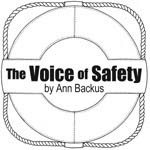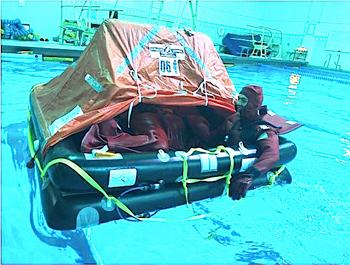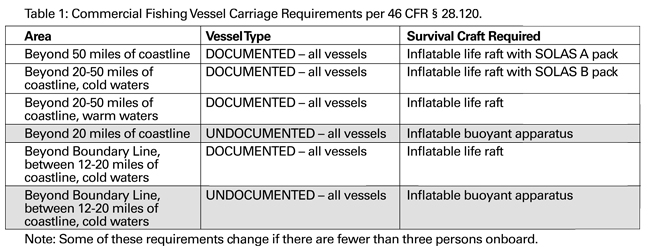Getting to Know Your Survival Craft
by Ann Backus, MS

How far out are you going to fish this summer? 12 miles? 20 miles? 50 miles?
As you undoubtedly know, the distance from the coastline matters when it comes to complying with the US Coast Guard federal regulations regarding survival craft (46 CFR § 28.120).
For the purposes of discussion in this article, I have created a table of the carriage requirements for documented and undocumented vessels fishing beyond the Boundary Line and all areas beyond 12 miles from the coastline. It is clear from the table that the requirements for documented vessels in cold water are different from those for documented vessels in warm waters. In New England, except for close to shore areas, we fish in cold water. (Technically, the warm water designation does reach as far north as the Isles of Shoals off the New Hampshire coastline.)
Inflatable Life Raft Equipment

Training in the use of inflatable safety rafts at the Harvard School of Public Health. Ann Backus photo.
It is also clear that the requirements for documented vessels and undocumented vessels are different even for the same distance from the coastline. Documented vessels between 20 miles and 50 miles are required to have an inflatable life raft with SOLAS B pack, whereas undocumented vessels fishing beyond 20 miles are only required to have an inflatable buoyant apparatus. Similarly, documented vessels fishing between 12 and 20 miles in cold water must have an inflatable life raft while undocumented vessels only need an inflatable buoyant apparatus.
The hierarchy of survival craft from less protective to most protective is —- inflatable buoyant apparatus, inflatable life raft, inflatable life raft with SOLAS B pack, and inflatable life raft with SOLAS A pack.
Starting from the top of the list: The SOLAS A pack contains everything in SOLAS B and is the only survival craft with food rations. It also has more distress signals (parachute flares, flares and smoke) and more water than SOLAS B. SOLAS A includes a fishing kit. Obviously, therefore, outfitted for a longer period of time before rescue. The SOLAS B pack differs from the inflatable life raft by having a long list of items not found in the inflatable life raft. These include flares and smoke signals, a signal mirror, first aid kit, a whistle, two sponges – one to bail with, the other to collect condensation for drinking water, water storage bag, seasick bag and seasick pills, a waterproof flashlight, and a spare sea anchor.
SOLAS A and B have more items intended to assist the survivors than do inflatable life rafts without one of those packs.
The basic inflatable life raft contains equipment designed to retain the integrity of the raft itself and allow the survivors to retain their position or move to a better position. These items include a raft repair kit, repair clamps, manual inflation pump, paddles, sea anchor, heaving line and raft instructions. The only items that address personal needs are a rain water collector and individual thermal protective aids. All this equipment assigned to the basic inflatable life raft is also in the rafts with SOLAS packs.
The inflatable buoyant apparatus, lowest on the totem pole of survival craft, come only with paddles and have no canopy.

Rethinking Survival and a Safety Grab Bag
The next most important companion items to help ensure safety and rescue from a survival craft are your survival suit/Personal Flotation Device (PFD) and your EPIRB. Don your survival suit or PFD and grab your EPIRB before you head to the raft. Tie the EPIRB off to the raft and let it float near you. It will continue to send signals.
Here is another item to think about: A Safety Grab Bag. This item was shown in one of the survival at sea videos I viewed this week. As a crew, discuss what equipment is available in the type of survival craft you have, then brainstorm some additional items you could pre-pack in a grab bag that you would take when you abandon ship.
For example: If you have a basic life raft without a SOLAS pack you might want some SOLAS-grade flares, two parachute flares, a couple floatable cans of smoke, and a signal mirror. Also think about adding two sponges – one for gathering condensation to drink, some packaged water and food rations, a waterproof flashlight, seasick pills, a small first aid kit, and perhaps hats for each person (if no canopy).
Controversies
I noticed two controversies in the survival videos. One was around water. One video promoted drinking water as needed and the other said, do not drink water for 24 hours. Water is necessary for survival. Lack of water/dehydration affects the ability to think clearly and make decisions. Digestion and metabolism require water; if you are eating candy bars or food rations, you need water. Given that many of us, including fishermen, do not drink enough water during the day, the practicality is that we will need hydration sooner rather than later. I side with those who suggest drinking and rationing water as needed.
The second controversy involved when to shoot off flares. One video said shoot off a parachute flare soon after you enter the raft; the other said, wait until a boat or plane is visible. If you pack your grab bag with two parachute flares, you have the option of using one at the outset and saving the other for when a vessel or plane is in view.
Refreshing your Knowledge
There are a number of ways you and your crew can refresh your knowledge about deployment and use of your life raft and its equipment.
• Check out this comprehensive video produced by AMSEA (Alaska Marine Safety Education Association) at https://www.youtube.com/watch?v=w-SeqXE8y6M.
• Find a safety training program near you. McMillan Offshore Survival Training www.mcmillanoffshore.com or Fishing Partnership Support Services https://fishingpartnership.org/services/safety-training/
• Talk with marine suppliers especially those who service life rafts. Chase Leavitt www.chaseleavitt.com
As Coast Guard personnel often say, in order to be safe and be rescued you need to have the right equipment, be sure it is working, and know how to use it.
Whether you are going out 12, 20 or more than 50 miles, prepare for a safe trip and a safe return.
Ann Backus, MS is an Instructor in Occupational Health at Harvard School of Public Health, 665 Huntington Ave., Boston MA 02 5, 617-432-3327, abackus@hohp.harvard.edu.
